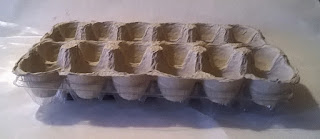There are many advantages to starting seed in containers. I can seed into clean media such as potting soil, coir (the fiber from coconut shells), peat, or rock wool cubes. I can start the seed indoors, either in my house, a greenhouse, or a shed, which means I can control the temperature of the environment and the media I'm using. And, when I go to plant, I can transplant the seedlings into a clean bed or one that's been mulched for weed control. It's more work to start the plugs and then transplant, but I feel that, in the long run, not having to deal with weeds more than makes up for that little bit of extra labor on the front end of the process.
There are many ways to start seed in containers. Plug trays are a great way to do this. The trays are reusable, inexpensive, and when cared for, will last several years. There are also paper cups, peat or coir pellets, pulp egg cartons, cardboard tubes and nursery pots.
I'll be writing more on those other seed starting methods in later articles, but today's article is about using pulp egg cartons and pulp egg flats to start seed for transplanting. I like to use these for starting lettuce, endive, romaine, escarole, fennel, basil, and some root crops. Basically any crop that would benefit from transplanting shortly after germination and that doesn't do well if the roots are disturbed.
They're not so good for crops that need deeper media prior to transplant, such as solanums (tomato, pepper, etc.), corn, squash, cucumbers, etc.
Pulp egg carton. Good for more than just egg storage. The cells in the tray (bottom) are great small containers for seed starting, and, if the lid is solid, seed for carrot, turnip, or other types of roots that don't like transplanting, can be used. Once the seed sprouts, just place the lid on the prepared soil and let the plant grow down through it.
I like using pulp cartons because they're inexpensive. If you buy eggs from the store you probably have some laying about even as you read this. If you don't buy eggs from the store you probably have friends who do and they have cartons that you could ask for. They also disintegrate when you plant, adding carbon rich material to the soil and allowing the roots from your plants to grow out through them. When you transplant, all you have to do is to pull the cells apart and place them, plant and all, into the soil, just as you would with a peat or coir pellet or a plant started in a peat or coir nursery container. This reduces transplant shock.
Because they're made of paper pulp, these egg cartons become very fragile when they get wet, so they will need to be supported. Any water proof or water resistant container will do.
Egg trays in a pastry tray
You can use just about any kind of container. This is a pastry tray. I've used one 18 count carton and one 12 count carton. One row of cells was cut off the end of each to make them fit the tray, but the tray now holds 25 cells. And it came with a dome, which helps with germination. The pastry was mighty tasty too. As a side note, when ever I buy a product, I always look at the container, thinking about what I can use it for. In this case, the container helped make the sale of the pastry. It's also why, when I buy eggs from the store, I usually buy them in pulp egg cartons.
Although, sometimes buying eggs in a plastic or foam tray does have its advantages. The plastic tray that the pulp egg carton trays are in was given to me by a friend who thought I could use it. He was right.
If you buy lots of eggs from the store, you might consider buying them in flats like this one. Or you might be able to get used flats from a restaurant. Egg flats make great seed starting containers, as long as they're made of paper pulp. A standard flat holds 30 eggs. If you were to buy that many coir or peat pellets you might spend upwards of $5. The flat you'll get for free.
All content, including pictures, © Joanne Rigutto, unless otherwise noted.




No comments:
Post a Comment